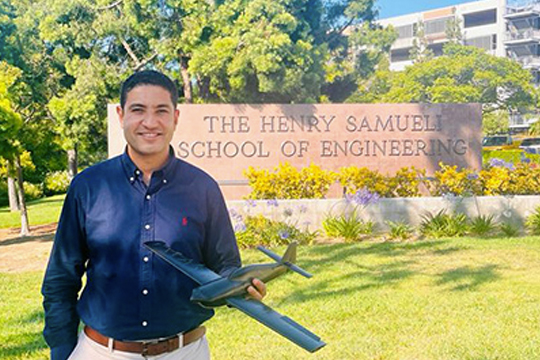Rep. Katie Porter Takes Note of Taha’s New Aerodynamics Theory of Lift

Sept. 6, 2023 - Haithem Taha’s aerospace engineering research has caught the attention of U.S. Rep. Katie Porter. Taha’s group developed a new theory of lift, which not only solves a century-old technical challenge in aerodynamics, but also fundamentally changes how researchers understand flight. The congresswoman sent Taha a letter congratulating him on a recent $1 million National Science Foundation grant to further validate his theory.
“Visionaries like yourself are the backbone of our district and what makes Orange County so special,” wrote Porter. “Thank you for your dedication and service to our community and I am beyond excited to see what you accomplish with this opportunity!”
With the NSF funding, Taha, associate professor of mechanical and aerospace engineering, is working with Peter Taborek, professor of physics and astronomy, to study the flow of a superfluid over various wing shapes to experimentally verify the role of viscosity in lift generation. Taha says the research will show the physics of the unsteady lifting mechanism, which is currently solely attributed to viscous effects, and will lead to a new understanding of the role of viscosity in fluid mechanics.
Currently, the main theory of lift taught in aeronautical engineering schools and found in textbooks is attributed to German mathematician Martin Kutta, published in 1910. Kutta’s theory, however, is confined to special types of shapes of airplane wing sections: those with a single sharp edge at the rear. It fails to apply if wings have multiple sharp edges, no sharp edges, a single sharp edge in the front, or even a single rear sharp edge in an unsteady flow. The new variational theory of lift applies the Hertz principle of least curvature, which is rarely found in textbooks of classical physics, and is generally applicable to all those cases.
“This project asks, can airplanes fly in superfluid?” said Taha. “If the result is positive, it will lead to a new theory of lift from first principles in physics in contrast to the classical theory, and it will correct the accepted wisdom about the viscous nature of lift generation. Our study will resolve the 300-year-old d’Alembert paradox by showing that his zero-force solution was only one of many possible solutions of Euler’s equation. And in numerous cases, nature selects a lifting solution."
“After validation by the superfluid experiments, we expect the new theory will replace the classical theory in aeronautical engineering schools as well as applied math and physics departments throughout the world,” said Taha.
– Lori Brandt
